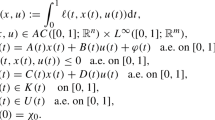Abstract
Let a control system be described by a continuous linear map ℒ* from the input spaceU* (some dual Banach space) into the output spaceX* (some finite-dimensional normed space). Within the class of control problems where the constraints and cost are expressed in terms of the norms on the input and output spaces, the following two have had extensive coverage: (i)minimum effort problem: find, from amongst all inputs which have corresponding outputs lying in some closed sphere inX* centered on some desired outputx d *, an output of minimum norm; and (ii)minimum deviation problem: find, from amongst all inputs lying in some closed sphere inU*, an input having corresponding output at a minimum distance fromx d *. However, thecomposite cost problem, where we seek to minimizeF(∥u*∥, ∥x d * −x*∥) over elements satisfyingx* = ℒ*u* (F a certain kind of convex functional), has not received the same attention. This paper presents results for the composite cost problem paralleling known results for the minimum effort and deviation problems. It is hoped that a gap in the literature is thereby filled. We show that (a) a solution exists, (b) the solution can be characterized in terms of some closed hyperplaneH inX, and (c)H can be computed as being an element on which some concave functional over closed hyperplanes inX achieves its maximum. The treatment allows of infinite-dimensional output spaces. We make extensive use of recently developed duality theory.
Similar content being viewed by others
References
Vidyasagar, M.,Optimal Control by Direct Inversion of a Positive-Definite Operator in a Hilbert Space, Journal of Optimization Theory and Applications, Vol. 7, No. 3, 1971.
Pearson, J. D.,Reciprocity and Duality in Control Programming Problems, Journal of Mathematical Analysis and Applications, Vol. 10, No. 2, 1965.
Pearson, J. D.,Duality and a Decomposition Technique, SIAM Journal on Control, Vol. 4, No. 1, 1966.
Van Slyke, R. M., andWets, R. J. B.,A Duality Theory for Abstract Mathematical Programs with Applications to Optimal Control Theory, Journal of Mathematical Analysis and Applications, Vol. 22, No. 3, 1968.
Heins, W., andMitter, S. K.,Conjugate Convex Functions, Duality and Optimal Control Problems, 1: Systems Governed by Ordinary Differential Equations, Information Sciences, Vol. 2, No. 1, 1970.
Neustadt, L. W.,Synthesis of Time-Optimal Control Systems, Journal of Mathematical Analysis and Applications, Vol. 1, No. 2, 1960.
Neustadt, L. W.,Minimum Effort Control Systems, SIAM Journal on Control, Vol. 1, No. 1, 1962.
Brøndsted, A.,Conjugate Convex Functions in Topological Vector Spaces, Matematiskfysiske Meddelelser Udgivet af det Kongelige Danske Videnskabernes Selskab, Copenhagen, Vol. 34, No. 1, 1964.
Rockafellar, R. T.,Level Sets and Continuity of Conjugate Convex Functions, Transactions of the American Mathematical Society, Vol. 123, No. 1, 1966.
Rockafellar, R. T.,Extension of Fenchel's Duality Theory for Convex Functions, Duke Mathematical Journal, Vol. 33, No. 1, 1966.
Rockafellar, R. T.,Duality and Stability in Extremum Problems Involving Convex Functions, Pacific Journal of Mathematics, Vol. 21, No. 1, 1967.
Edwards, R. E.,Functional Analysis, Holt, Rinehart, and Winston, New York, New York, 1965.
Taylor, A. E.,Introduction to Functional Analysis, John Wiley and Sons, New York, New York, 1958.
Dunford, N., andSchwartz, J. T.,Linear Operators, Vol. 1, John Wiley and Sons (Interscience Publishers), New York, New York, 1958.
Luenberger, D. E.,Optimization by Vector Space Methods, John Wiley and Sons, New York, New York, 1968.
Neustadt, L. W., andPaiewonsky, B. H.,On Synthesizing Time Optimal Controls, Paper presented at the 2nd IFAC Congress, Basle, Switzerland, 1963.
Bellman, R.,Notes on Control Processes—1; On the Minimum of Maximum Deviation, Quarterly of Applied Mathematics, Vol. 14, No. 4, 1957.
Author information
Authors and Affiliations
Additional information
Communicated by S. E. Dreyfus
This research was supported by the Science Research Council of Great Britain and the Commonwealth Fund (Harkness Fellowship).
Rights and permissions
About this article
Cite this article
Vinter, R.B. Application of duality theory to a class of composite cost control problems. J Optim Theory Appl 13, 436–460 (1974). https://doi.org/10.1007/BF00934940
Issue Date:
DOI: https://doi.org/10.1007/BF00934940




